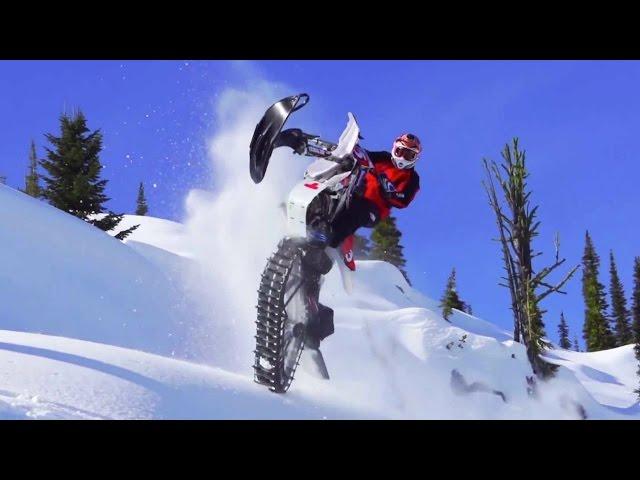The early morning air around us is translucent white with slow-falling snow, as we drive up north. This is our last day in Kelowna and we're preparing to return to our grand motorcycle trip. While the rest of Canada complains bitterly about the ceaseless snow, we are having a blast in this winter wonderland! The Okanagan has collected over two meters of base, which has made our snowboarding vacation quite successful! It's also made conditions perfect for gradually easing us back onto two wheels - because we're trying out snowbiking today!

We've rented a couple of snow bikes in Vernon, about 45 minutes north of Kelowna. We follow the pick-up truck, loaded with our new steeds, further north towards Silver Star. There's a snowmobiling area just outside the ski resort called Sovereign Lake, where we park and unload the snowbikes.
In my mind, I'm mentally tallying the cost of owning and running these machines: long-bed pick-up truck, ramps, wheel kit for the front ski. Not to mention the cost of the snow bikes themselves! The nice thing about snowbikes over snowmobiles is that you can cram a whole bunch into the back of a truck without having to install a deck if you want to carry more than one.

So... what exactly is a snowbike?
It's a dirtbike with a couple of modifications to make it similar to a snowmobile: a single ski attached to the front forks and a narrower rear track system. So basically a single track snowmobile which can lean and go places the wider snowmobile can't!
Sounds right up our alley!

We've brought a variety of bikes up to the trails. The most common snowbike is built around a four-stroke 450cc dirtbike. It's nice to have the linear predictability and tractability of a four-stroke plus the grunt of a 450 to power the rear track through thick powder! Today, we're testing out a KTM 450, a Husqvarna 450 and another Husky 350.

We've rented a couple of snow bikes in Vernon, about 45 minutes north of Kelowna. We follow the pick-up truck, loaded with our new steeds, further north towards Silver Star. There's a snowmobiling area just outside the ski resort called Sovereign Lake, where we park and unload the snowbikes.
In my mind, I'm mentally tallying the cost of owning and running these machines: long-bed pick-up truck, ramps, wheel kit for the front ski. Not to mention the cost of the snow bikes themselves! The nice thing about snowbikes over snowmobiles is that you can cram a whole bunch into the back of a truck without having to install a deck if you want to carry more than one.

So... what exactly is a snowbike?
It's a dirtbike with a couple of modifications to make it similar to a snowmobile: a single ski attached to the front forks and a narrower rear track system. So basically a single track snowmobile which can lean and go places the wider snowmobile can't!
Sounds right up our alley!

We've brought a variety of bikes up to the trails. The most common snowbike is built around a four-stroke 450cc dirtbike. It's nice to have the linear predictability and tractability of a four-stroke plus the grunt of a 450 to power the rear track through thick powder! Today, we're testing out a KTM 450, a Husqvarna 450 and another Husky 350.
Last edited:












